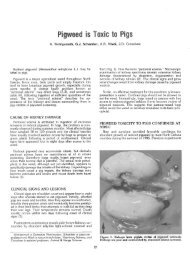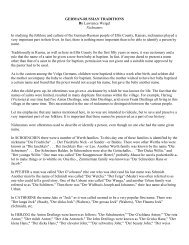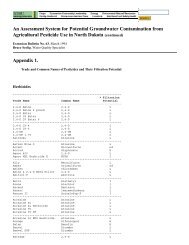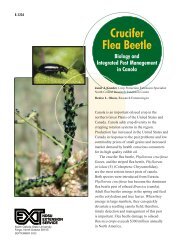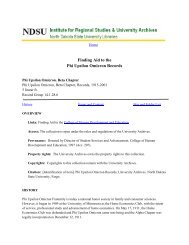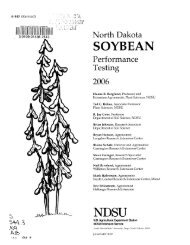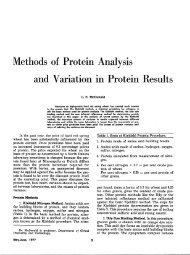Grain Drying
Grain Drying
Grain Drying
Create successful ePaper yourself
Turn your PDF publications into a flip-book with our unique Google optimized e-Paper software.
Oil Sunflower 10 8Wheat 14 13-----------------------------------------<strong>Grain</strong> can be stored at a higher moisture content withoutsignificant fungus development when stored at coldertemperatures. Table 2 shows the relationship between moistureand temperature and its effect on allowable storage time forcereal grains.Table 2. "Approximate" Allowable Storage Time(days) For Cereal <strong>Grain</strong>s.----------------------------------------------------Temperature (F)M.C. --------------------------------------------(%) 30 40 50 60 70 80----------------------------------------------------14 * * * * 200 14015 * * * 240 125 7016 * * 230 120 70 4017 * 280 130 75 45 2018 * 200 90 50 30 1519 * 140 70 35 20 1020 * 90 50 25 14 722 190 60 30 15 8 324 130 40 15 10 6 226 90 35 12 8 5 228 70 30 10 7 4 230 60 25 5 5 3 1----------------------------------------------------Based on composite of 0.5 percent maximum dry matterloss calculated on the basis of USDA research at lowaState University; Transactions of ASAE 333-337, 1972;and "Unheated Air <strong>Drying</strong>," Manitoba Agriculture Agdex732-1, rev. 1986.*Approximate allowable storage time exceeds 300 days.The allowable storage time for corn has been established to bethe time until a 0.5 percent dry matter reduction is reached. Atthat point there will be a reduction of one grade. Storage life iscumulative. If half of the storage life is used before the grain isdried, only half of the indicated storage time at the lowermoisture content is available after the grain has been dried.A rough estimate of storage life for oil crops mightalso be made based on the values for corn using anadjusted moisture content calculated using theequation:Comparable Corn Moisture Content =Oil Seed Moisture Content x 100.--------------------------------100 - Seed Oil ContentFor example, oil sunflower at 12.0 percent moisturecontent is comparable to corn at 20 percent moisturecontent.Comparable Corn Moisture Content =12--------- x 100 = 20%100 - 40
Influence of <strong>Drying</strong> ConditionsAirflow rate, air temperature and air relative humidity influencedrying speed. In general, higher airflow rates, higher airtemperatures and lower relative humidities increase dryingspeed.Raising the temperature of the drying air increases the moisturecarryingcapacity of the air and decreases the relative humidity.As a general rule of thumb, increasing the air temperature by 20degrees Fahrenheit (F) doubles the moisture-holding capacity ofair and cuts the relative humidity in half.The drying rate depends on the difference in moisture contentbetween the drying air and the grain kernel. The rate of moisturemovement from high moisture grain to low relative humidity air israpid. However, the moisture movement from wet grain to moistair may be very small or nonexistent. At high relative humidities,dry grain may pick up moisture from the air.The airflow rate also affects drying rate. Air carries moistureaway from the grain, and higher airflow rates give higher dryingrates. Airflow is determined by fan design and speed, fan motorsize and the resistance of the grain to airflow. Deeper graindepths and higher airflow rates cause higher static pressuresagainst the fan. Higher static pressures decrease fan output.As air enters the grain, it picks up some moisture, which coolsthe air slightly. As air moves through a deep grain mass, the airtemperature is gradually lowered and relative humidity increaseduntil the air approaches equilibrium with the grain. If the airreaches equilibrium with the grain, it passes through theremaining grain without any additional drying. If high relativehumidity air enters dry grain, some moisture is removed from theair and enters the grain. This slightly dried air will begin to pickup moisture when it reaches wetter grain. Air in a 12 to 16 inchgrain column does not reach equilibrium with the grain.N E X TTypes of Dryers and <strong>Drying</strong>Energy, Quality, Fire, Moisture and FansHeaters, Costs, Safety and Managing Stored <strong>Grain</strong>AE-701 (Revised), November 1994County Commissions, North Dakota State University and U.S. Department of Agriculture cooperating. North Dakota State University does notdiscriminate on the basis of race, color, national origin, religion, sex, gender identity, disability, age, status as a U.S. veteran, sexual orientation, maritalstatus, or public assistance status. Direct inquiries to the Vice President for Equity, Diversity and Global Outreach, 205 Old Main, (701) 231-7708. Thispublication will be made available in alternative formats for people with disabilities upon request, 701 231-7881.Information for Prospective StudentsNDSU is an equal opportunity institutionThis information may be photocopied for noncommercial, educational purposes in its entirety with no changes.Requests to use any portion of the document should be sent to NDSU.permission@ndsu.edu.
North Dakota State University Agriculture and University ExtensionDept. 7070, Morrill 7, P.O. Box 6050, Fargo, ND 58108-6050



